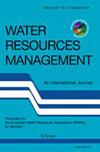评价雾收集器的网格几何和阴影系数
IF 3.9
3区 环境科学与生态学
Q1 ENGINEERING, CIVIL
引用次数: 0
摘要
地球上维持生命最宝贵的资源是水。在干旱和半干旱地区,利用雾收集器的雾收集技术可以解决缺水问题。雾的采集受多种因素的影响很大。有些是设计参数,而另一些则取决于周围环境。几何形状和网格的遮荫系数是重要的设计因素,可以修改,并对雾收集器中的雾收集率产生影响。网格孔的形状和用于创建网格的过程用于识别几何形状和测量阴影系数。本文提出了一种简单的数学技术,可以更容易地计算雾收集中使用的各种网格形状的阴影系数,并提供网格体积和成本的近似值。使用了五种可选择的几何形状:矩形网格、方形网格、拉舍尔网格、三角形网格和六边形网格。目前的简单方法将有助于雾网收集器的设计,并有助于实现理想的遮荫系数和最有效的雾收集网格几何形状。仅以矩形网格为例对结果进行了评价。采用不同遮光系数的不锈钢矩形网进行雾收集试验,每个网收集的水量不同。结果表明,雾的最佳遮荫系数为50 ~ 60%。本文章由计算机程序翻译,如有差异,请以英文原文为准。
Evaluating Mesh Geometry and Shade Coefficient for Fog Harvesting Collectors
Abstract The most valuable resource for sustaining life on earth is water. In dry and semi-arid areas, the problem of water scarcity can be resolved with the aid of fog collection techniques employing fog collectors. Fog collection is greatly influenced by a variety of factors. Some are design parameters, while others depend on ambient circumstances. Geometry and the mesh’s shade coefficient are important design factors that can be modified and have an impact on the rate at which fog collects in fog collectors. The shape of the mesh holes and the process used to create the mesh serve to identify geometry and measure the shade coefficient. In this paper, a straightforward mathematical technique is proposed to make it easier to calculate the shade coefficient of various mesh shapes used in fog harvesting and to provide an approximation of the mesh volume and cost. Five alternative geometries were used: the rectangular mesh, square mesh, Raschel mesh, triangular mesh, and hexagonal mesh. The current simple method will facilitate the design of the fog mesh collector and can assist in achieving the ideal shade coefficient and most effective mesh geometry for fog harvesting. Rectangular meshes were solely used as an example to evaluate the results. Stainless steel rectangular meshes with various shade coefficients were tested for fog collection, and the amount of water collected by each mesh varied. It was concluded that the optimum shade coefficient ranged 50–60% for fog collection.
求助全文
通过发布文献求助,成功后即可免费获取论文全文。
去求助
来源期刊

Water Resources Management
环境科学-工程:土木
CiteScore
7.40
自引率
16.30%
发文量
332
审稿时长
9 months
期刊介绍:
Water Resources Management is an international, multidisciplinary forum for the publication of original contributions and the exchange of knowledge and experience on the management of water resources. In particular, the journal publishes contributions on water resources assessment, development, conservation and control, emphasizing policies and strategies. Contributions examine planning and design of water resource systems, and
operation, maintenance and administration of water resource systems.
Coverage extends to these closely related topics: water demand and consumption; applied surface and groundwater hydrology; water management techniques; simulation and modelling of water resource systems; forecasting and control of quantity and quality of water; economic and social aspects of water use; legislation and water resources protection.
Water Resources Management is supported scientifically by the European Water Resources Association, a scientific and technical nonprofit-making European association.
 求助内容:
求助内容: 应助结果提醒方式:
应助结果提醒方式:


